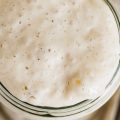Not a fan of airy, hole-ridden sourdough that lets all your butter and jam slip through? Listen, we’ve all been there – you slice into your freshly baked sourdough, expecting a satisfying chew, only to find yourself with a bread that’s more air than substance. It’s like biting into a cloud, and let’s face it, clouds make terrible sandwiches. Let’s dive into creating dense, hearty carb-laden sourdough loaves that make sturdy slices capable of supporting the mightiest of toppings!

Table of Contents
- Understanding Sourdough Density
- Adjusting Hydration Levels
- Flour Choices
- Kneading Techniques
- Fermentation Control
- Shaping and Proofing
- Baking Tips
- Troubleshooting and Tips
- How to Make Your Sourdough More Substantial
- How to Make Sourdough More Dense: FAQs
Understanding Sourdough Density
Sourdough density is influenced by a complex interplay of factors, including gluten development, fermentation, and hydration.
Gluten, the protein network formed by mixing flour and water, plays a crucial role in determining your bread’s texture. A well-developed gluten structure traps the gases produced during fermentation, resulting in a lighter, airier crumb. However, if gluten development is lacking or the dough is under-fermented, your sourdough may turn out denser than desired.
Several key factors contribute to the density of your sourdough bread.
Firstly, the type and quality of flour used can significantly impact the final product. Flours with higher protein content, such as bread flour, tend to produce a stronger gluten network, leading to a more open crumb.
Secondly, the hydration level of your dough – the ratio of water to flour – can also affect density. A higher hydration dough generally results in a more open, lighter texture, while a lower hydration dough may yield a denser loaf.
One common misconception is that dense sourdough is always a sign of failure. However, different types of sourdough bread have varying desired densities. For example, a hearty, rustic sourdough may be intentionally denser than a light and airy baguette.
Another misconception is that adding more yeast or sourdough starter will automatically make the bread lighter. In reality, over-fermentation can lead to a collapse in the gluten structure, resulting in a dense, gummy texture.
Adjusting Hydration Levels
The amount of water relative to flour in your dough – known as the hydration ratio – plays a crucial role in determining the final texture of your bread. As a general rule, lower hydration doughs tend to produce denser, more compact loaves, while higher hydration doughs result in a more open, airy crumb.
So, how do you nail that ideal hydration level for your desired density? It’s all about experimentation and finding that sweet spot. If you’re aiming for a denser sourdough, try reducing the water in your recipe by 5-10%. This will create a stiffer, less sticky dough that’s easier to handle and shape. Remember that the flour you’re using also affects hydration, so be prepared to adjust based on your specific ingredients.
As you mix your sourdough, pay close attention to the consistency of the dough. A denser loaf requires a dough that’s slightly firmer and less extensible than its airier counterparts. When kneading, stretching, and folding, look for a dough that holds its shape well and doesn’t spread out too easily. If your dough is too slack or sticky, try incorporating more flour until you achieve the desired consistency.
Don’t be discouraged if your first attempts don’t yield the exact results you were hoping for. With each bake, you’ll gain valuable insights into how hydration levels affect your bread’s density.
Flour Choices
Different types of flour bring unique characteristics to the table, influencing not only the flavor profile but also the texture and density of your loaf.
Bread flour is your go-to ally. With its higher protein content compared to all-purpose flour, bread flour is a champ at developing a strong gluten network. This robust gluten structure helps to create a tighter crumb, resulting in a delightfully dense texture. Plus, the extra protein gives your bread a satisfying chew that’ll keep you coming back for more.
For a bit of wholesome goodness in dense sourdough, whole wheat flour is the way to go. Milled from the entire wheat kernel, this flour packs a nutritional punch and adds a delightful nutty flavor to your bread. The bran and germ present in whole wheat flour also contribute to a denser texture, as they tend to absorb more water and disrupt gluten development. Just keep in mind that whole wheat flour can be a bit thirsty, so you may need to adjust your hydration levels accordingly.
Rye flour is here to add a tangy twist to your loaf. With its lower gluten content and unique flavor profile, rye flour is a fantastic choice for crafting a dense, moist crumb with a distinct character. The natural enzymes in rye flour also contribute to a slower fermentation process, allowing your dough to develop complex flavors over time. Pro tip: Try combining rye flour with bread flour for a perfect balance of density and structure.

Kneading Techniques
When aiming for a denser loaf, find the sweet spot between under-kneading and over-kneading. Under-kneaded dough will result in a crumbly, weak texture, while over-kneaded dough can become tough and chewy.
There are several kneading methods you can employ to create a dense sourdough. The traditional hand kneading method involves working the dough on a floured surface, pushing and folding it until it becomes smooth and elastic. This hands-on approach allows you to get a feel for the dough’s consistency and make adjustments as needed.
Alternatively, you can use a stand mixer fitted with a dough hook to knead your sourdough. This method is particularly helpful when working with stiffer, lower hydration doughs that can be challenging to knead by hand.
Aim for a dough that feels firm and has a slight resistance to stretching. This indicates that the gluten has developed enough to create a tight crumb structure. As a general rule, knead your dough for 8-10 minutes by hand or 5-7 minutes in a stand mixer.
However, the exact timing may vary depending on your flour choice and hydration level. To test if your dough is ready, perform the windowpane test: gently stretch a small piece of dough until it’s thin enough to see light through. If it holds its shape without tearing, you’ve achieved the perfect level of gluten development for a dense sourdough.
Fermentation Control
One of the most significant factors in fermentation control is time. When aiming for a denser sourdough, you may want to consider a longer fermentation period. This extended process allows the dough to develop more complex flavors and a tighter crumb structure. Experiment with letting your dough ferment for an additional few hours and observe how it affects the final density of your bread.
Higher temperatures can accelerate the process, while lower temperatures slow it down. When seeking a dense sourdough, try fermenting your dough at a slightly cooler temperature, around 65-70°F (18-21°C). This slower fermentation will give the dough more time to develop a strong gluten network, resulting in a denser texture.
The strength of your sourdough starter can also impact the density of your bread. A more mature, robust starter will produce a stronger fermentation, leading to a more open crumb. If you’re after a denser loaf, consider using a younger or less active starter. This will slow down the fermentation process and contribute to a tighter crumb structure.
Keep a baking journal to track your progress and note how each variable affects the final result. With practice and patience, you’ll soon discover the fermentation sweet spot that yields your ideal dense sourdough.
Shaping and Proofing
Create a tight, well-structured loaf that will hold its shape during proofing and baking. One technique that works wonders for dense sourdough is the “stitching” method. Imagine you’re sewing up a seam on your favorite pair of jeans. Gently stretch the dough and fold it over itself, pinching the seams together to create a snug package. This method helps to build tension in the dough, resulting in a taller, denser loaf.
Once you’ve shaped your sourdough, it’s time to let it proof. Proofing is the final rise before baking, and it’s essential for developing flavor and texture. When aiming for a denser loaf, try proofing your dough in a proofing basket, also known as a banneton. These baskets are designed to support the shape of your dough and prevent it from spreading out too much. Line your proofing basket with a floured cloth, and gently place your shaped dough inside, seam-side up. Cover it with a damp towel and let it proof in a cool spot, around 65-70°F (18-21°C), for several hours or overnight.
To achieve that perfect dense sourdough, keep an eye on your dough during the proofing process. Overproofed dough can lead to a collapsed, gummy texture, while underproofed dough may result in a tight, undercooked crumb. So, how do you know when your dough is ready to bake? Try the poke test! Gently press your finger into the dough. If it springs back slowly, leaving a small indentation, it’s ready to go. If it springs back quickly, it needs a bit more time. And if it doesn’t spring back at all, you may have overproofed it.

Baking Tips
To achieve that perfectly crisp crust and a dense, chewy interior, consider investing in a baking stone. This handy tool helps to distribute heat evenly and absorbs moisture from the dough, resulting in a better rise and a more consistent crumb structure.
Place your baking stone on the middle rack of your oven and preheat it to a scorching 450-500°F (230-260°C) for at least an hour before baking. This high heat will give your sourdough a boost and promote a beautiful, golden-brown crust.
Steam is a baker’s secret weapon when it comes to creating a denser sourdough with a crisp, shiny crust. When you introduce steam into your oven during the first few minutes of baking, it helps to keep the dough’s surface moist and pliable. This allows your bread to expand fully before the crust sets, resulting in a taller, denser loaf.
To create steam in your home oven, try placing a shallow metal pan on the bottom rack during preheating. Just before loading your dough, carefully pour a cup of hot water into the pan, and quickly close the oven door to trap the steam inside.
Baking times can vary depending on your oven, the size of your loaf, and the density you’re aiming for. As a general rule, dense sourdough loves a longer bake at a slightly lower temperature. This slower bake allows the dough to develop a thick, caramelized crust while ensuring the interior is fully cooked and wonderfully chewy.
For a medium-sized loaf, start with a bake time of 35-40 minutes at 450°F (230°C). Keep an eye on your bread during the last 10 minutes of baking, and adjust the time as needed.
Prices pulled from the Amazon Product Advertising API on:
Product prices and availability are accurate as of the date/time indicated and are subject to change. Any price and availability information displayed on [relevant Amazon Site(s), as applicable] at the time of purchase will apply to the purchase of this product.
Troubleshooting and Tips
- If your sourdough is coming out denser than desired, there are a few key things to check. First, make sure your starter is active and bubbly before mixing your dough. An underactive starter can lead to a sluggish fermentation and a heavy loaf. Next, pay attention to your dough’s consistency during kneading – it should feel smooth and elastic, not sticky or shaggy. Finally, be patient during proofing. Rushing the rise can result in a dense, underproofed loaf.
- One pro tip is to try retarding your dough overnight in the fridge. This slow, cold fermentation helps to develop flavor and can contribute to a denser, chewier texture. Another trick is to experiment with adding inclusions like seeds, nuts, or dried fruit to your dough. These tasty mix-ins can help to break up the crumb structure and add pockets of delightful density throughout your loaf.
- One mistake many bakers make is overhandling the dough during shaping. While it’s important to create tension, overworking the dough can lead to a tight, dense crumb. Another misstep is slashing your dough too deeply before baking. Shallow scoring allows your loaf to expand and rise, while deep cuts can cause it to spread outwards and lose its loft.
How to Make Your Sourdough More Substantial
In conclusion, crafting the perfect dense sourdough requires patience, experimentation, and mastery. Focus on hydration levels, flour choices, kneading techniques, fermentation control, and shaping methods to achieve that coveted dense crumb. A baking stone, steam, and longer bake times at lower temperatures can contribute to a crisp crust and a chewy interior. Embrace the journey, learn from your mistakes, and savor the delicious rewards of your hard work. Armed with these tips and tricks, you’re on your way to dense sourdough success.
How to Make Sourdough More Dense: FAQs
What makes sourdough bread dense?
Several factors contribute to dense sourdough bread, including low hydration, overworked dough, insufficient fermentation, and improper shaping. Using too much flour, not allowing the dough to rest and develop gluten properly, or not allowing enough time for the dough to rise can all lead to a denser texture. Adjusting these variables can help achieve a more open crumb and lighter texture.
How do you make sourdough bread lighter and fluffier?
To make sourdough bread lighter and fluffier, increase the hydration of your dough by using more water relative to flour. Gently handle the dough to avoid overworking it, and allow sufficient time for fermentation and proofing. Use stretching and folding techniques to develop gluten structure without deflating the dough. Ensure your starter is active and healthy for optimal rise and a more open crumb.
How do you make bread more dense?
To make bread more dense, reduce the amount of water in your recipe, creating a drier dough. Knead the dough more thoroughly to develop a stronger gluten network. Decrease the amount of yeast or sourdough starter used, slowing down the fermentation process. Shorten the proofing time, preventing the dough from rising too much. These adjustments will result in a denser, more compact loaf.
How do I get more lift in sourdough?
To get more lift in sourdough, ensure your starter is active and at its peak before mixing the dough. Increase the hydration of your dough by using more water relative to flour. Use gentle handling techniques, like stretching and folding, to develop gluten without deflating the dough. Allow sufficient time for fermentation and proofing, and consider using a Dutch oven for better steam retention during baking.













